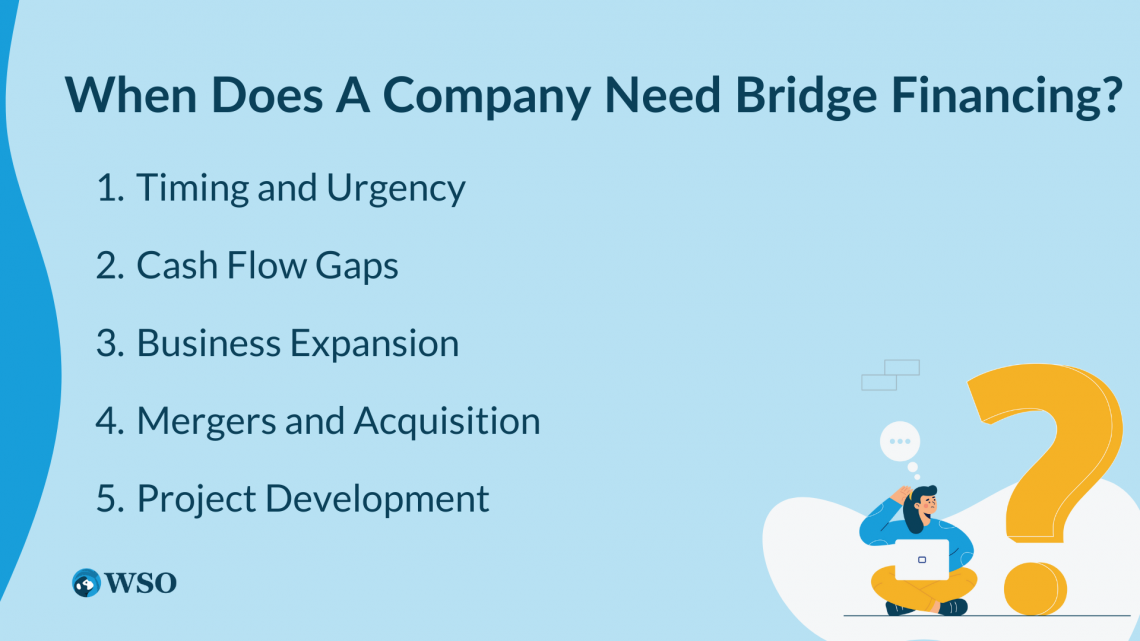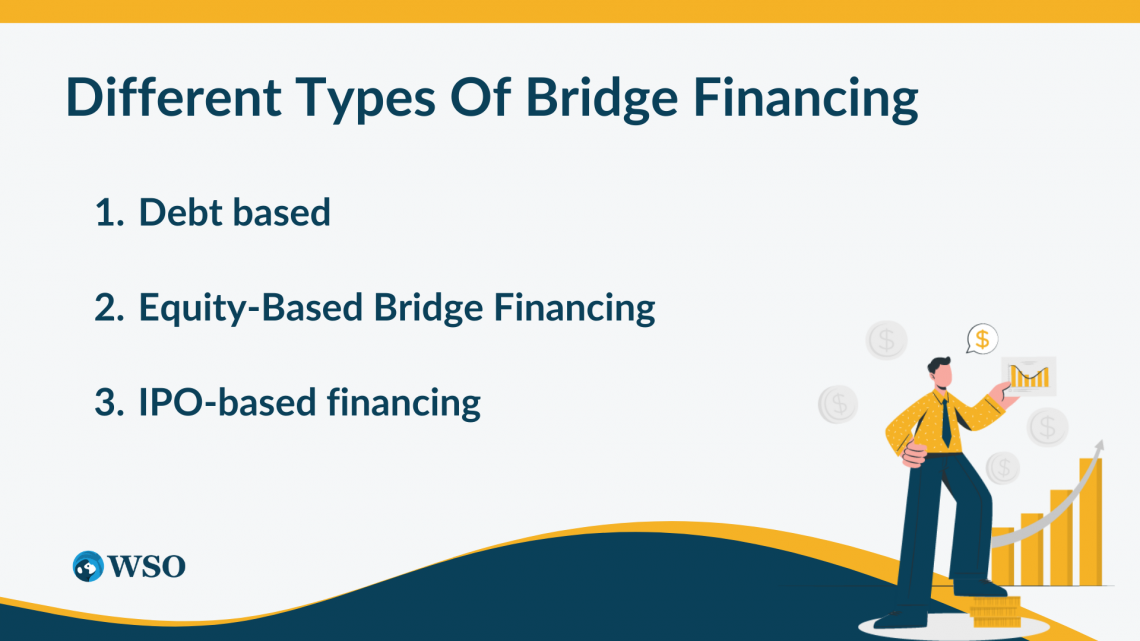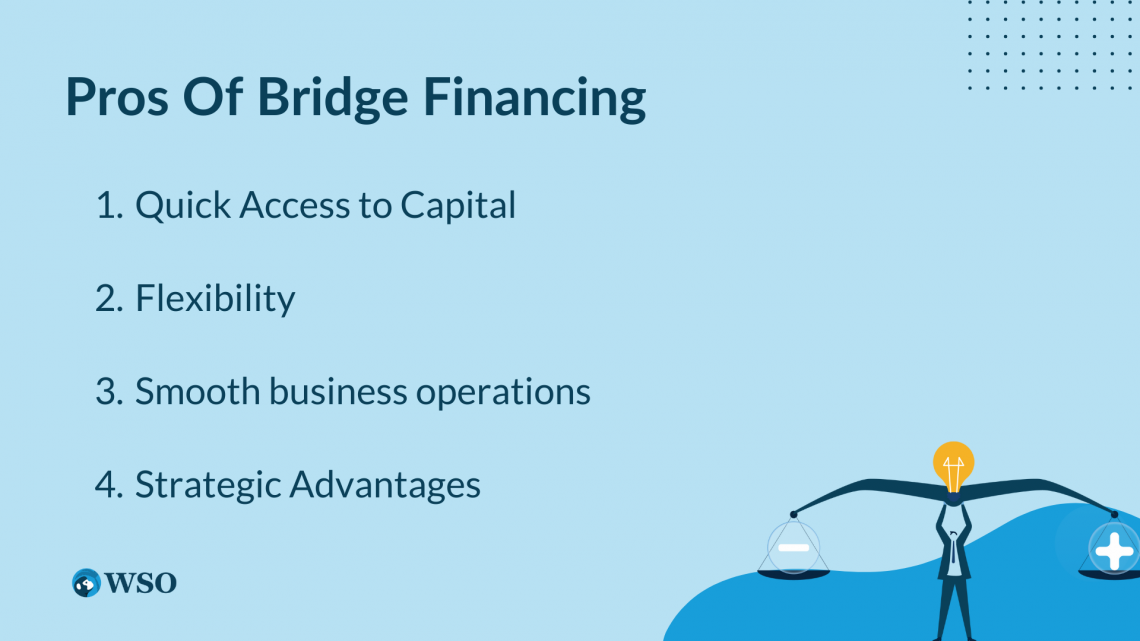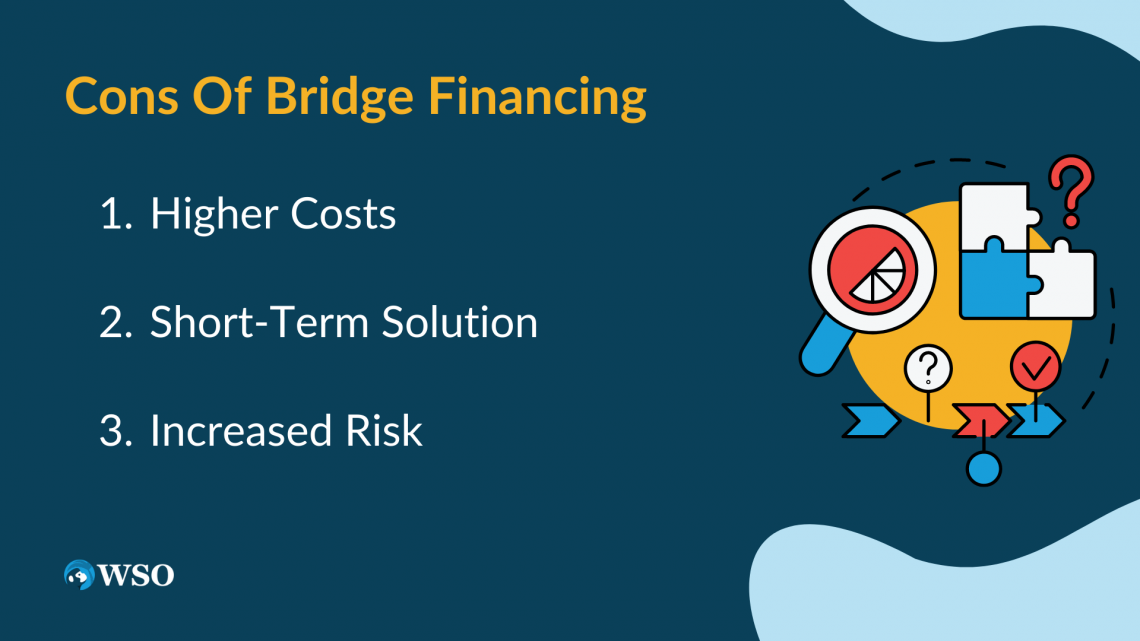Bridge Financing
Temporary financing option available for use until long-term funding is found
Bridge financing is a temporary financing option available for use until long-term funding is found. Hence, the word bridge indicates bridging the gap between the need for immediate capital and the availability of a more permanent financial solution.

It serves as an interim solution, providing quick access to funds to meet urgent financial obligations and opportunities or in anticipation of long-term financing. Some examples of a more stable and permanent financing option are bank loans, equity financing, or the sale of an asset.
The most common form of bridge financing is a bridge loan, which the company will use until long-term financing is available. Depending on the institution, these loans are short-term solutions ranging from 2 weeks to 3 years.
Different financing options are available for businesses depending on the circumstance. Companies, individuals, or organizations can get this type of financing through an investment bank, private lenders, or a venture capital firm.
The options provided by this financing range from debt, IPOs, and equity finance. An organization will decide which choice is suitable for its immediate needs. Usually, this type of finance will cover the borrower’s working capital needs.

Additionally, suppose a business is in a bad financial state and intends to use bridge funding to get back on its feet. In that case, their financing options will be limited compared to a different company in a more stable financial position.
Banks will determine a company's financial position by reviewing their credit history, financial records, and market position, similar to when an individual wants to obtain a loan. Lenders have a high risk in providing bridge financing options and will use high-interest rates and expensive methods to protect.
Key Takeaways
- Bridge financing is a short-term form of funding that helps individuals, businesses, or organizations fulfill working capital needs.
- This type of financing is used in the form of debt, equity, or IPOs.
- The most common form of bridge financing is a bridge loan.
- Bridge financing is generally more costly than traditional funding methods.
- It serves as a solution when there is a temporary need for capital and can help facilitate timely business operations or investment opportunities while awaiting long-term solutions.
When Does a Company Need Bridge Financing?
Bridge financing is a crucial financial tool in various situations, providing organizations with short-term funding to address immediate capital needs. Some organizations might need help finding a traditional funding method and look up to bridges as their solution.

Bridge funding is usually not the first financing choice of a person because it comes with a lot of risk for both the borrower and lender. However, it proves to be some institutions' only option when faced with timely business ventures or a deteriorating financial position.
The terms of bridge financing, such as interest rates, repayment period, and collateral requirements, vary based on the lender and the specific situation.
NOTE
The interest rates and fees are significantly higher than standard methods because of the risk and short-term nature.
Even though it is more expensive, organizations worldwide see value in this financing because it gives leniency to businesses and, for some, adds more sand into their hourglass. Here are some key reasons why bridge financing is commonly used:
1. Timing and Urgency
This financing is often utilized when there is a pressing need for immediate capital, and traditional financing options may not be readily available within the required timeframe.
It allows individuals or organizations to seize time-sensitive opportunities or address urgent financial obligations promptly. Additional capital can remove any business conflict when pursuing new product lines or expansion measures.
Example
Iin real estate transactions, bridge financing can enable the acquisition of a new property before the sale of an existing one, preventing potential delays and missed opportunities.
2. Cash Flow Gaps
Temporary gaps in cash flow can occur for various reasons, such as seasonal fluctuations, delays in client payments, or unexpected expenses.
Bridge financing helps bridge these temporary gaps by providing the necessary working capital to cover operational expenses, payroll, or other short-term financial obligations. It ensures that daily operations can continue smoothly without disruptions.
3. Business Expansion
When businesses aim to expand their operations, they often require additional capital to fund growth initiatives, such as opening new locations, launching new products, or investing in marketing and advertising campaigns.
NOTE
Short-term financing can facilitate these expansion plans by offering quick access to funds. At the same time, businesses wait for long-term financing options, such as bank loans or equity financing, to materialize.
4. Mergers and Acquisition
During an acquisition, acquiring companies may require immediate funding to complete the deal while waiting for more extensive financing arrangements or finalizing due diligence processes.
With this type of capital on hand, companies may be able to continue a deal. Using the bridge method ensures that the money is available to execute the transaction and secure the target company, enabling timely M&A activities.
5. Project Development
Bridge financing is frequently employed in project-based industries, such as real estate development or infrastructure projects. It allows developers to initiate and progress projects while seeking funding from investors or financial institutions.
By securing short-term financing, developers can commence construction, cover initial costs, and demonstrate progress to attract further investment or secure permanent financing.
NOTE
Bridge Financing is especially important in project development because the construction of buildings and other facilities almost always has specific dates the structure needs to be completed.
Implementing bridge funding allows the company to progress with its assembly without prolonging or delaying its completion.
This short-term financing method proves helpful in many ways. There are even more reasons for an institution to choose bridge funding. However, these are the most typical ways this type of financing is implemented.
NOTE
Whether for urgent situations, business expansion, or M&A transactions, bridge financing provides individuals with the necessary funds to address time-sensitive opportunities or obligations while waiting for more permanent financing arrangements to materialize.
Different Types Of Bridge Financing
There are many different forms of this financing to serve various financial needs. A company's choice of the type of financing they employ should be based on the specific financial burdens they want to address.

Each type of bridge financing serves different needs and comes with its terms, conditions, and risks.
NOTE
It's essential for individuals and organizations to carefully assess their requirements, financial situation, and repayment capabilities before choosing the most suitable form.
Businesses sometimes seek professional advice from financial experts or consultants to make informed decisions regarding financing options. Professional help could be of value, primarily because of the high risk attached to bridge funding.
The most common types of funding include debt, equity, and initial public offerings (IPOS). We’ll dive into each of these in greater detail.
1. Debt based
Debt-based financing involves obtaining short-term loans or credit facilities to bridge the gap between immediate capital needs and long-term funding.
It is most common in various scenarios and can be provided by banks, private lenders, or alternative financing sources. Debt-based bridge financing typically requires collateral, such as real estate or inventory, to secure the loan.
The borrower agrees to repay the loan amount, interest, and fees within the agreed-upon term. Bridge loans, swing loans, and factoring/invoice financing are examples of debt-based bridge financing.
NOTE
The most common type of loan in debt-based lending is a bridge loan. They will have higher fees and rates as a direct reflection of their higher risk. Regardless, these loans are still an excellent and popular choice for short-term financing.
2. Equity-Based Bridge Financing
Equity-based financing involves raising capital by selling ownership shares or equity in the company to bridge the funding gap. This is often used by startups, early-stage companies, or companies undergoing significant growth or expansion.
The investors become shareholders of the company, which means they hold an equity stake and may have certain rights and privileges associated with their ownership. The investors expect a return on their investment through growth and success.
NOTE
Angel investors, venture capital firms, convertible bridge financing, and equity crowdfunding are different avenues for companies to access equity-based financing, each with advantages and considerations.
Two standard equity-based bridge financing options are:
- Convertible bridge finance: The loan can be converted into equity later, providing flexibility and allowing the investor to benefit from the potential upside of the company's growth.
- Equity crowdfunding: It allows companies to raise capital from a large pool of individual investors contributing smaller amounts of money. It provides quick access to a broader investor base and accumulates smaller investments to meet capital needs.
3. IPO-based financing
This type of bridge financing involves a private company raising capital by conducting an initial public offering (IPO) of its shares through an investment bank. The company uses the IPO to bridge the funding gap between its current capital needs and future funds.
NOTE
The goal of the financing is to cover the expenses of the IPO and have the money raised from the offering pay off the loan. This happens by underwriting the stock, while the company will issue the shares to the bank at a discount as payment.
This financing can benefit a company through increased market visibility, future financing opportunities, liquidity outlets, and capital infusions.
Pros And Cons Of Bridge Financing
It's crucial for borrowers to carefully evaluate their specific financial situation, objectives, and risk tolerance before considering this financing. Let’s discuss the pros and cons associated with bridge financing.

The advantages of bridge financing are as follows.
1. Quick Access to Capital
Immediate capital is a must as it provides a timely solution for companies. This can be crucial for funding time-sensitive projects, covering operating expenses, or taking advantage of business opportunities.
2. Flexibility
It offers flexibility in terms of repayment options and terms. It can be customized to align with the borrower's financial situation and expected future cash flows.
NOTE
The terms can be negotiated with the lender, allowing for more flexibility than traditional financing options.
3. Smooth business operations
It helps bridge temporary funding gaps during transitional periods, such as between property sales. This ensures that businesses can continue their operations smoothly without disruptions.
4. Strategic Advantages
It allows businesses to seize time-sensitive opportunities, such as acquisitions or expansions, before securing traditional financing. By accessing bridge funding, companies can act swiftly and gain a competitive edge in the market.
The drawbacks of bridge financing are as follows.

1. Higher Costs
Bridge finance comes with higher interest rates, fees, and other associated costs than long-term financing options. The short-term nature of bridge loans and the perceived higher risk for lenders contribute to these elevated costs.
2. Short-Term Solution
It is only a temporary funding solution and not a long-term financial strategy. The repayment period is relatively short. Failure to secure long-term financing or meet repayment obligations can result in additional financial strain.
3. Increased Risk
It involves inherent risks, both for the borrower and the lender. The borrower is taking on additional debt and must carefully assess their ability to repay it. On the lender's side, there is a risk of non-repayment, which can impact their ROI.
Summary
Bridge funding is a short-term solution for companies' problem of finding long-term financing methods. This type of financing has many benefits, such as the maintenance of business operations, gap funding, and quick capital access.

However, this is not too good to be true for companies because of its expensive fees and rates. It is imperative for distressed companies to strategically decide if this is the best financing method to prevent further ruin.
Investment banks, angel investors, and venture capital firms are the standard lending hands behind this financing method. They will thoroughly look through an organization's credit history to ponder if this will be a risky investment for them.
This type of funding is good for institutions that need extra time to find a long-term financing option as long as they have the working capital to fund the expensive rates and fees that come along with it.
Because of its expensive nature, most businesses do not view this funding as their first option but more as a last resort when they are in a time crunch.
Institutions can choose between various ways they’d like to finance their operations, whether through debt, equity, or IPOs. Banks will help these organizations choose the proper method for both parties involved.




or Want to Sign up with your social account?